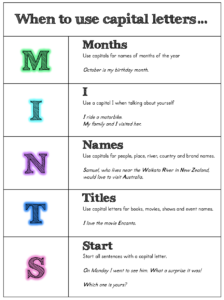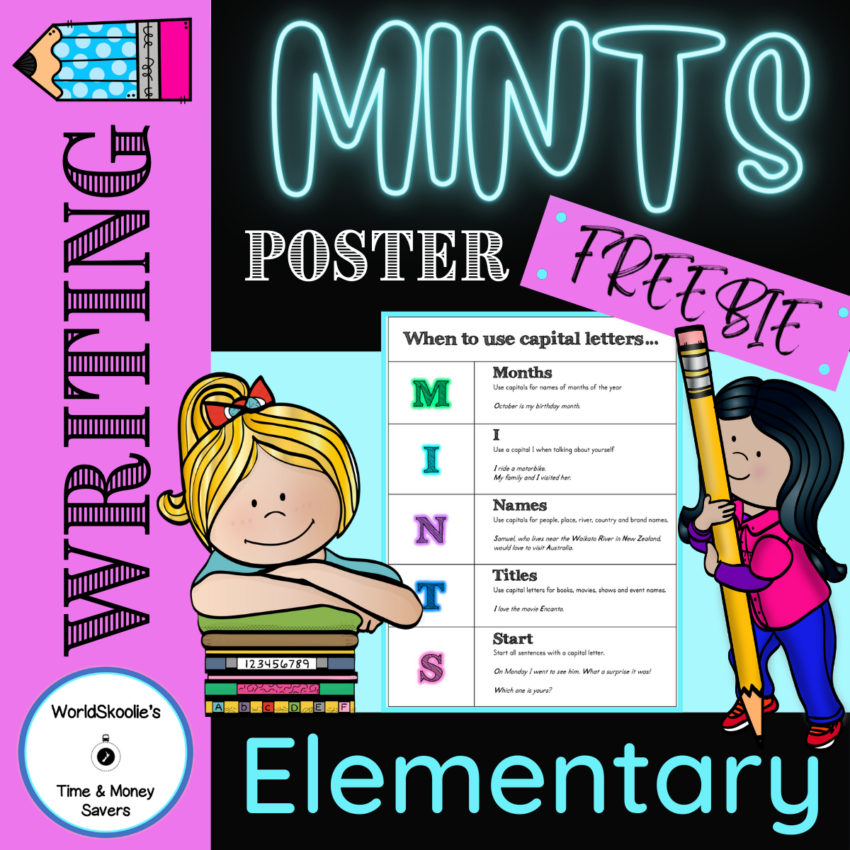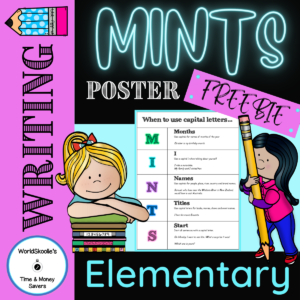Writing is a fundamental skill that children develop from a young age, and mastering the use of capital letters is a crucial part of this process.
Capitalisation helps to distinguish proper nouns, the beginning of sentences, and other important elements in written communication.
For many young writers though, remembering to use capital letters consistently can be a challenge!
Almost every day in the classroom I’ve found myself reminding kids to use capitals appropriately. Maybe you have too?
Then I came across this handy mnemonic device that can make this learning process more engaging and memorable: MINTS.
What is MINTS?
MINTS is an acronym that stands for:
-
M – Months
-
I – as in the pronoun ‘I’
-
N – Names
-
T – Titles
-
S – Start of sentences
This mnemonic serves as a simple and effective way to remind children of the situations where capital letters should be used in their writing.

Let’s break down each component of MINTS and how it can be applied:
Months
Encourage children to capitalise the names of months of the year when they write dates or talk about specific times of the year. For example:
- “My birthday is in January.”
I
The pronoun ‘I’ should always be capitalised, whether it’s used in a sentence by itself or as part of a larger statement:
- “I love to play soccer with my friends.”
Names
Proper nouns, such as names of people, places, and specific things like mountains and rivers, should always start with a capital letter:
- “John and Sarah went to the park.”
Titles
When referring to titles of books, movies, songs, or any other works, the first letter of each major word should be capitalised:
- “Have you read Harry Potter and the Philosopher’s Stone?”
Start of Sentences
Every sentence should begin with a capital letter, no matter where it falls in a paragraph or story:
- “Today is a sunny day. My dog loves to play outside.”
How to Implement MINTS in Learning
Introduce the Concept:
Start by explaining what MINTS stands for and give examples of each category. Show children how capitalisation helps make their writing clearer and more organised.
Practice Exercises:
Provide worksheets or interactive activities where learners can practice identifying and using capital letters according to the MINTS mnemonic. Use sentences with missing capitals and have students correct them.
Games and Challenges:
Make learning fun by turning it into a game. For example, have a race to see who can correctly capitalise the most words according to MINTS in a given time.
Writing Prompts:
Give writing prompts that specifically require the use of capital letters in accordance with MINTS. This helps reinforce the concept in context.
Reinforcement:
Continuously remind children to use MINTS in their everyday writing. Provide positive reinforcement when they remember to capitalise correctly.
Final thoughts
Mastering capitalisation is an essential step in a child’s journey towards becoming a confident writer.
By using the MINTS mnemonic, educators and parents can simplify this process and make it more engaging for young learners.
By incorporating MINTS into their learning routine, children can develop a habit of using capital letters correctly, ensuring their writing is clear, coherent, and effective.
So, next time you’re helping a child with their writing skills, remember the power of MINTS to make capitalisation both memorable and meaningful!
I made a free MINTS poster as a visual reminder of the process and refer learners to it often. I hear them say, ‘Oh yes!’
I hope it’ll be useful to you and your learners too, helping to solve the problem of poor use of capitals and editing while saving you time and energy.
Click on the image below to grab it.
To get other FREE and paid time and money-saving educator resources check out Worldskoolie’s TPT store.
If you want help on how to get started making your own resources for TPT, check out this post.
Thanks for stopping by!

Meagan



